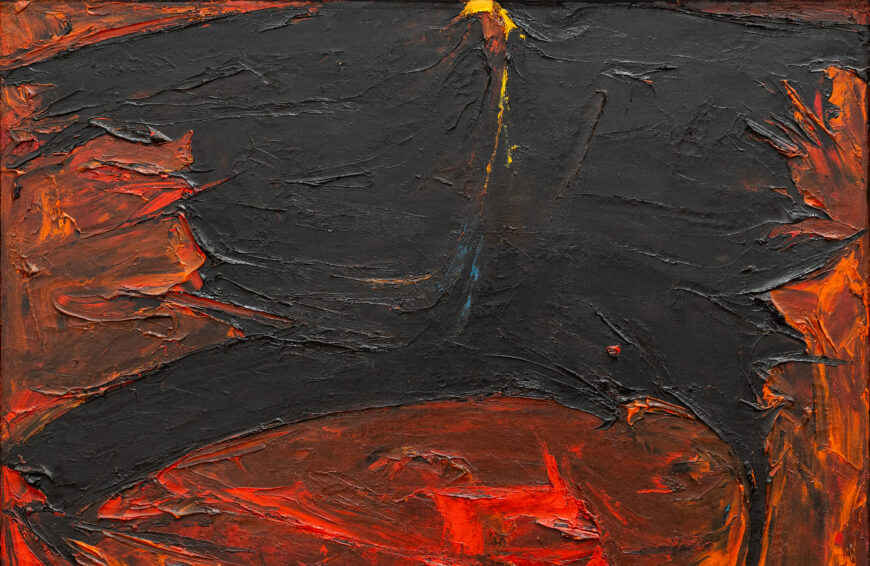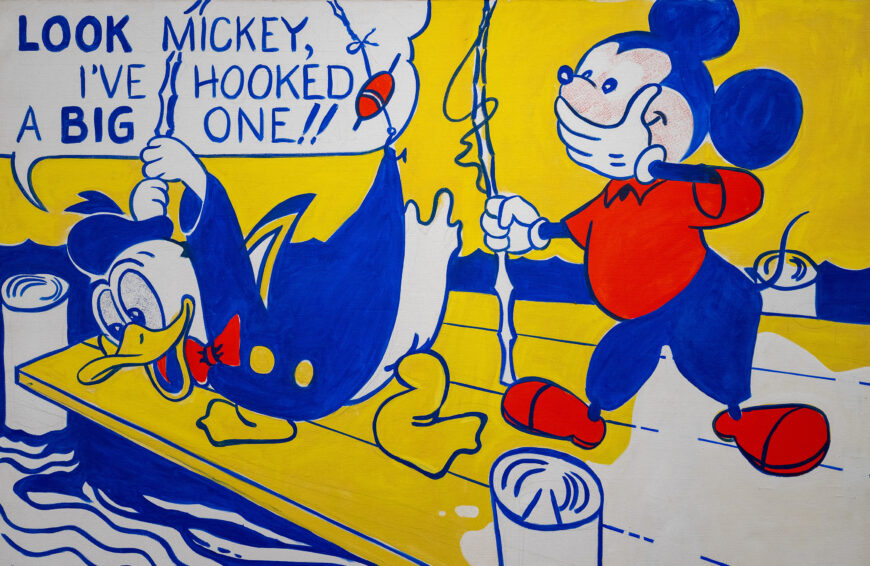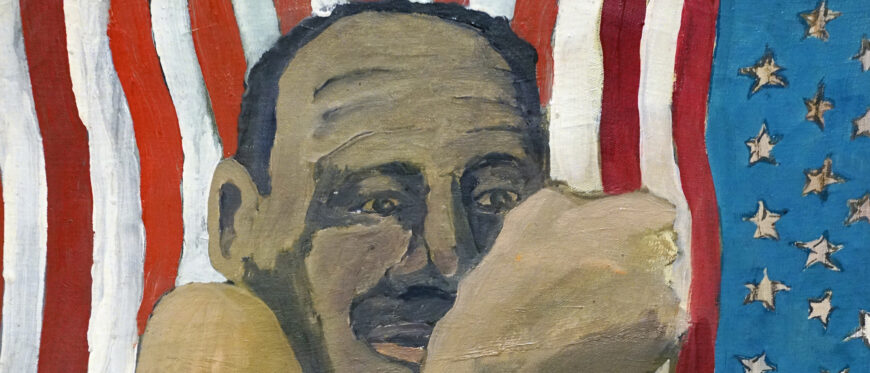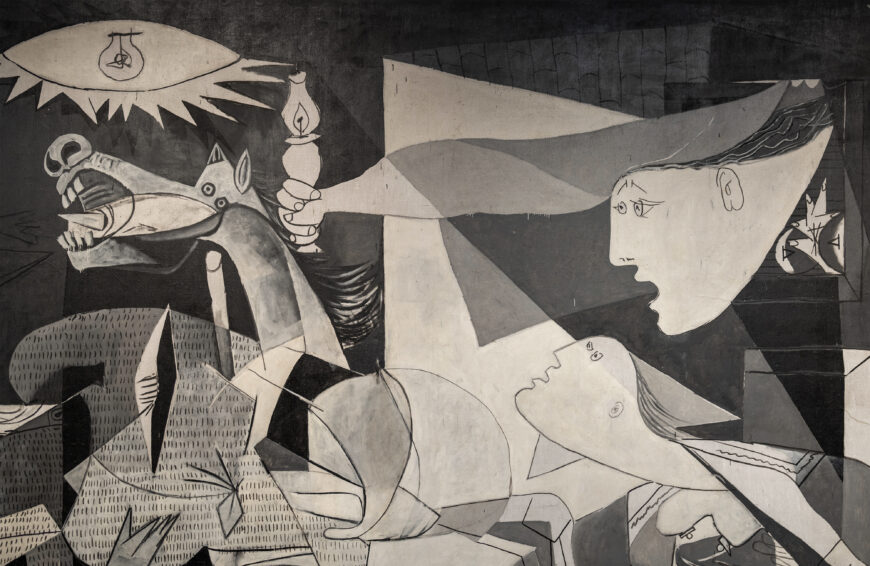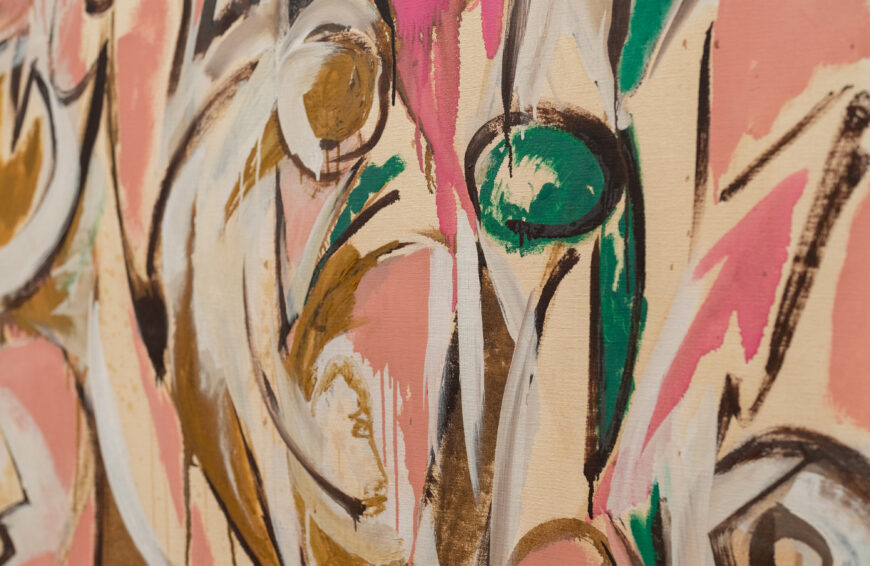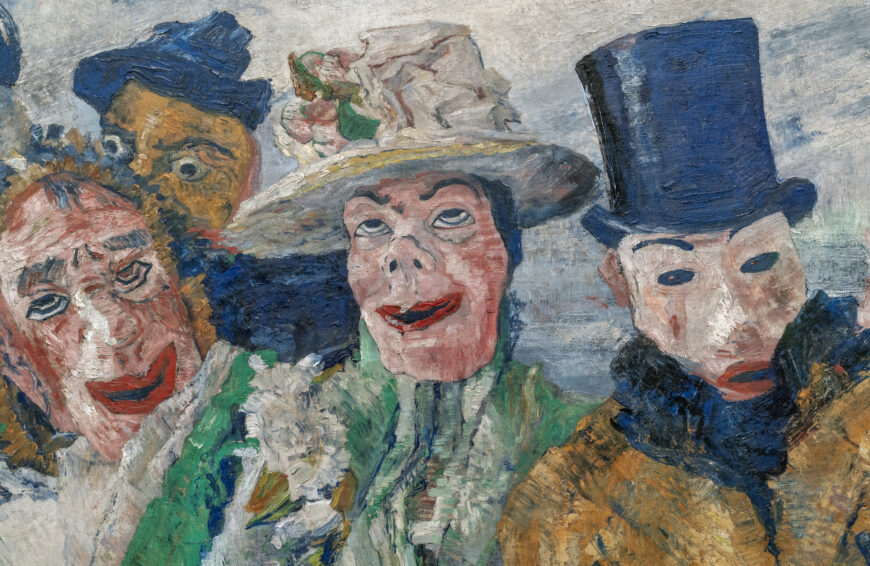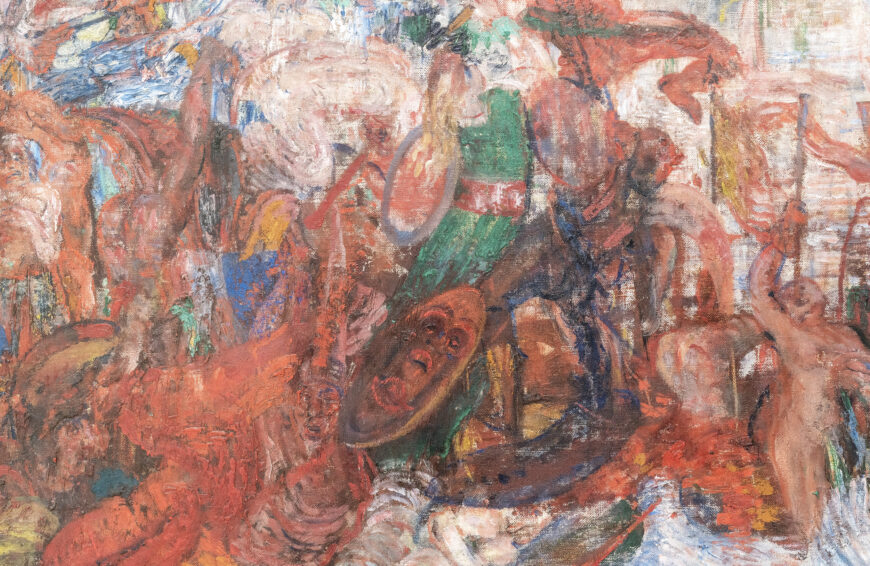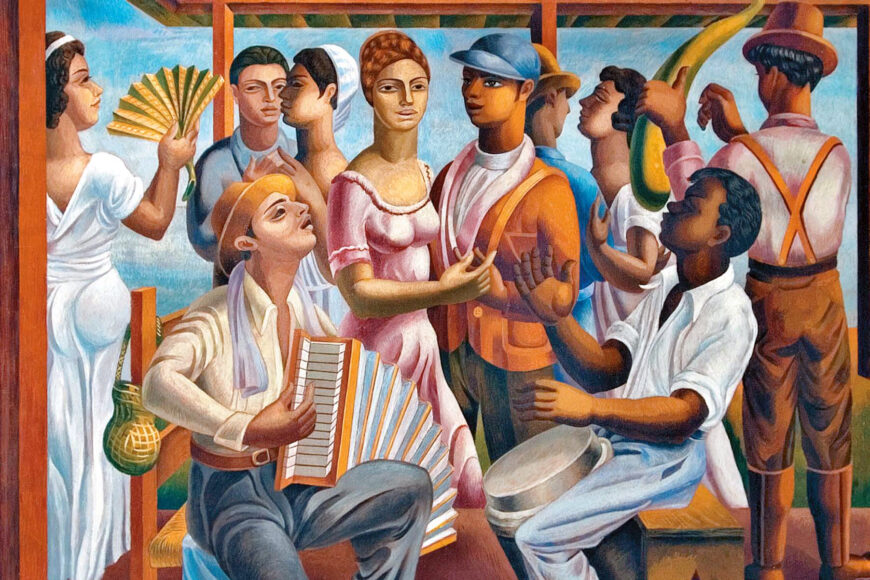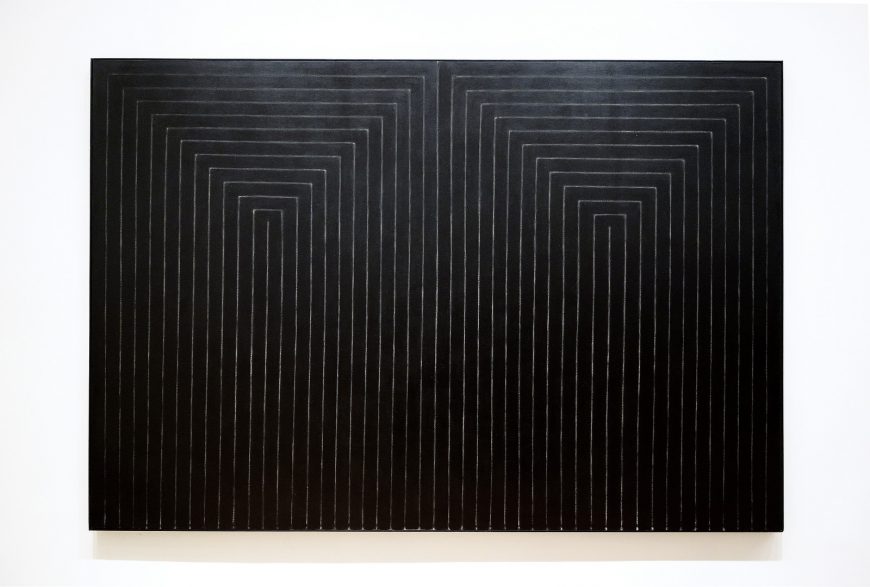
Frank Stella, The Marriage of Reason and Squalor, II, 1959, enamel on canvas, 230.5 x 337.2 cm (The Museum of Modern Art, New York)
The best known American abstract painting of the 1950s was gestural and emotionally expressive (see below). This art, known as Abstract Expressionism was just that. It was abstract, but more to the point, it was subjective—it was about the experience and the very being of the artist. Frank Stella’s early series, the “Black Paintings” of 1958-1959 (below), was none of these things. The Marriage of Reason and Squalor II, one of that series, is characterized by thick black lines painted to alternate repeatedly with thin “stripes” of exposed canvas—with no room for gesture. The series features an array of designs made by differently arranging these same elements in symmetrical rectilinear patterns.
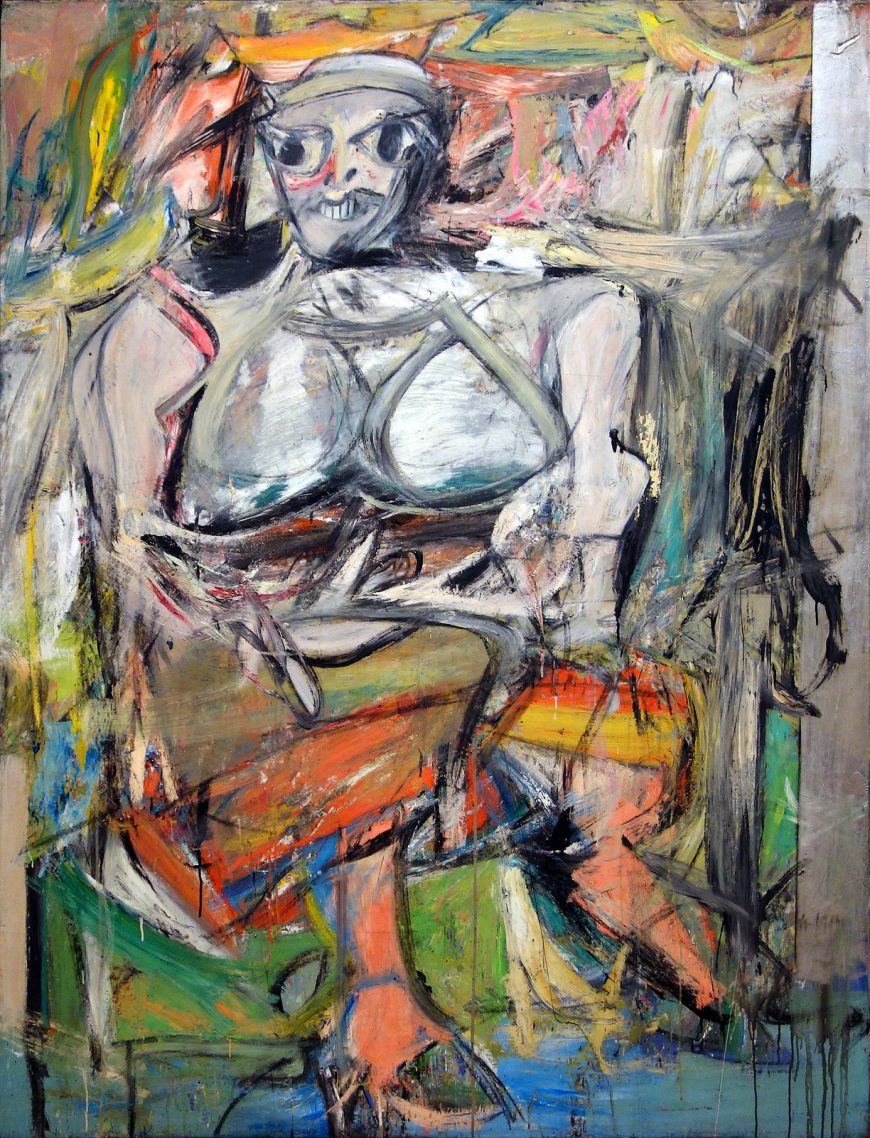
Willem de Kooning, Woman I, 1950-52, oil on canvas (The Museum of Modern Art, New York)
Stella’s early paintings are often associated with Minimalism which also begins at about this time. Like the Minimalists, Stella heralds the literal presentation of spare abstract forms. His technical approach—constructing each stroke with a wide housepainter’s brush and enamel house paint—highlights the shift among many artists of the time to reject the gestural style of action painting typical of Abstract Expressionism, the preeminent American art movement of the 1950s. By contrast, works like The Marriage of Reason and Squalor II exhibit a controlled sensibility that speaks to the systematic planning and conceptual framework that belie their simplistic appearance.
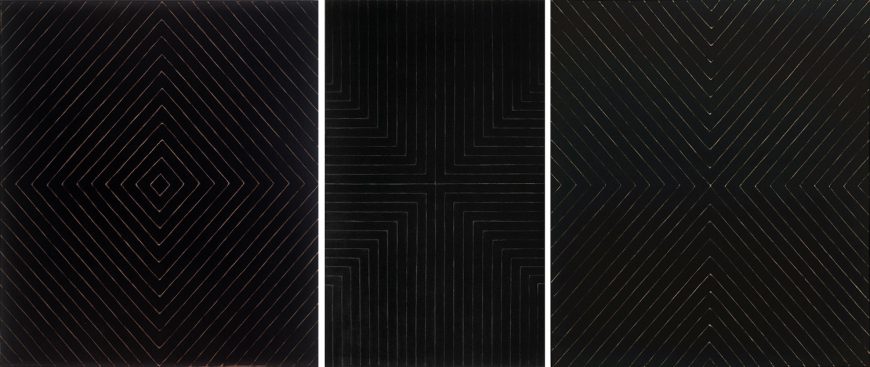
Selected Black Paintings (from left to right): Frank Stella, Jill, 1959, enamel on canvas, 229.6 x 200 cm (Buffalo AKG Art Museum); Frank Stella, Die Fahne Hoch!, 1959, enamel on canvas, 308.9 × 184.9 cm (Whitney Museum of American Art, New York); Frank Stella, Zambezi, 1959, enamel on canvas, 230.51 x 200.03 cm (SFMOMA)
Rejecting emotion
Stella wanted to eliminate the personal reference and symbolic meaning associated with modernist abstract painting. In this way, his paintings differ from those of European modernists like Piet Mondrian who used reductive geometrical forms to communicate spiritual ideals. Stella criticized the work of these earlier painters as too “relational,” a term he used to describe their subjective process of arranging distinct parts in relation to one another in order to create what they saw as a harmonious and balanced composition. [1]
Jasper Johns was an important influence on Stella in these formative years. Working in the 1950s, Johns had also rejected the metaphysical overtones of Abstract Expressionism in his ironic use of encaustic, an ancient media that requires careful application to build up layers of wax and pigment, and reference to everyday objects. Johns’ deliberate mark-making denied action painting’s insistence on the spontaneity of individual expression, and his rendering of easily recognizable targets and flags mocked one of Abstract Expressionism’s claims—to communicate universal meaning through archetypal images.
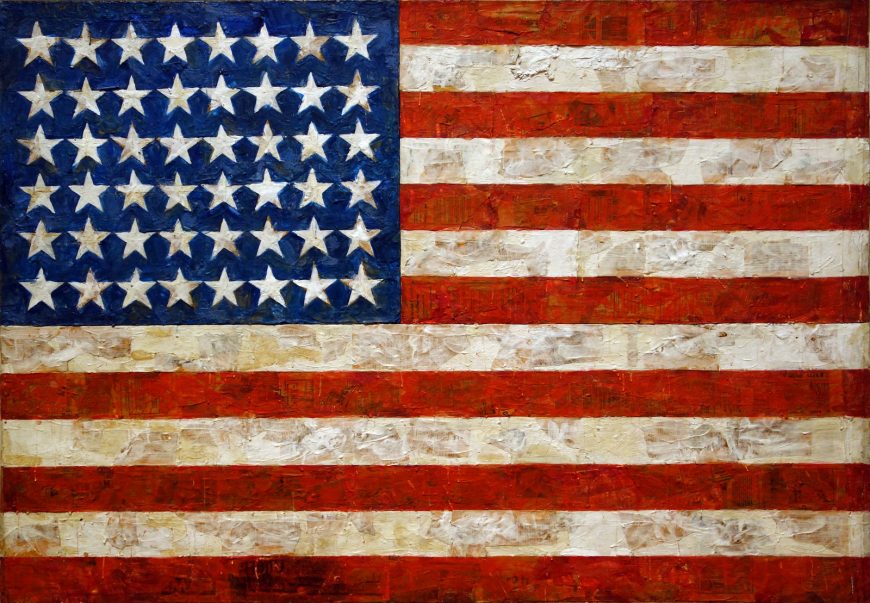
Jasper Johns, Flag, 1954–55 (dated on reverse 1954), encaustic, oil, and collage on fabric mounted on plywood, three panels, 107.3 x 153.8 cm (The Museum of Modern Art, New York)
For Stella, Johns’s art hinted at a way to eliminate the subjectivity inherent to the artist’s task. Representing an existing object meant that the appearance and structure of the thing itself determined the painted imagery. Johns’s use of repetition further appealed for its visible adherence to the artist’s subject matter, and suggested to Stella a systematic, detached approach to artmaking based on a predetermined motif.
“What you see is what you see”
Stella adapted these ideas for his own non-objective imagery (images that don’t depict recognizable forms) by looking to the rectangular shape of the canvas as the basis for his compositions. He explained this rationale in 1960 to students at Pratt Institute in Brooklyn:
I had to do something about relational painting . . . . The obvious answer was symmetry—make it the same all over. The question still remained though, of how to do this in depth. A symmetrical image or configuration symmetrically placed on an open ground is not balanced out in the illusionistic space. The solution I arrived at . . . forces illusionistic space out of the painting at constant intervals by using a regulated pattern. The remaining problem was simply to find a method of paint application which followed and complemented the design solution. This was done by using the house painter’s technique and tools. [2]
Although painted by hand, the image’s methodical regularity erased any sign of the artist’s individuality or emotional investment in his work. In adopting “the house painter’s technique and tools,” Stella replaced the romanticized notion of an artist’s creative act with the actual labor used to make a painting. In this way, the Black Paintings challenged the assumption that a painting must represent an ideal or communicate profound meaning to the viewer—a position summed up best in Stella’s famous quip, “What you see is what you see.”
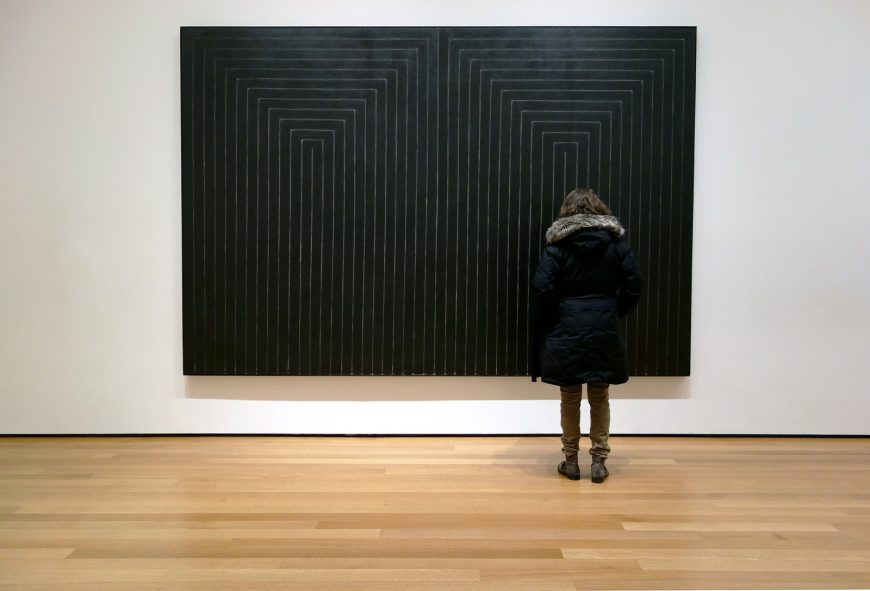
Gallery view: Frank Stella, The Marriage of Reason and Squalor, II, 1959, enamel on canvas, 230.5 x 337.2 cm (The Museum of Modern Art, New York)
Stella’s solution not only eliminated the subjectivity of abstract painting, it also forced the viewer’s attention to the materials of the painting itself. Repeating the striped pattern to fill the canvas emphasized the flatness of the painted surface, an effect heightened by building up thick layers of dense black enamel to obscure brushstrokes and texture. The result was to deny the viewer the illusion of depth usually perceived in paintings, and to highlight the symmetrical design that echoed the rectangular shape of the canvas itself.
For artists like Donald Judd, who also wanted to rid art of its metaphysical meaning and illusionistic tradition, Stella’s Black Paintings appealed for their object-like appearance. Stella used deep stretcher bars which caused his paintings to stand out further from the wall. Judd, who is best known for his Minimalist sculpture, argued that Stella’s paintings emphasized the three-dimensionality of the painting as a real object that extended into the space of the gallery itself. Likewise, the human scale of the canvas seemed to heighten the art’s physical relationship to the viewer, a characteristic of Minimalism in sculpture. Stella rejected these interpretations, however, insisting that his primary interest was the viewer’s optical experience.
The title
For all of Stella’s emphasis on painting’s formal properties (that is how the painting looks as opposed to what it represents), the provocative titles of his Black Paintings compel speculation about deeper meaning. These includes Nazi references such as Arbeit Macht Frei and Die Fahne Hoch, and places such as Arundel Castle (a favorite subject of English Romantic painters). The general tendency of the titles to reflect what Stella called “‘downbeat’ and ‘depressed political’ situations” suggests they say more about the artist and the world around him than the paintings themselves. [3] In the case of The Marriage of Reason and Squalor II, Stella’s orderly pairing of identical halves plays on the contrasting terms in the title. It was Carl Andre, Stella’s long-time friend and fellow artist, who first invented the title in 1957 for a series of his own pastel drawings that he destroyed. Because both men agreed the phrase was an apt characterization of their lives as artists in New York City, Andre suggested Stella use the title for his painting. [4]
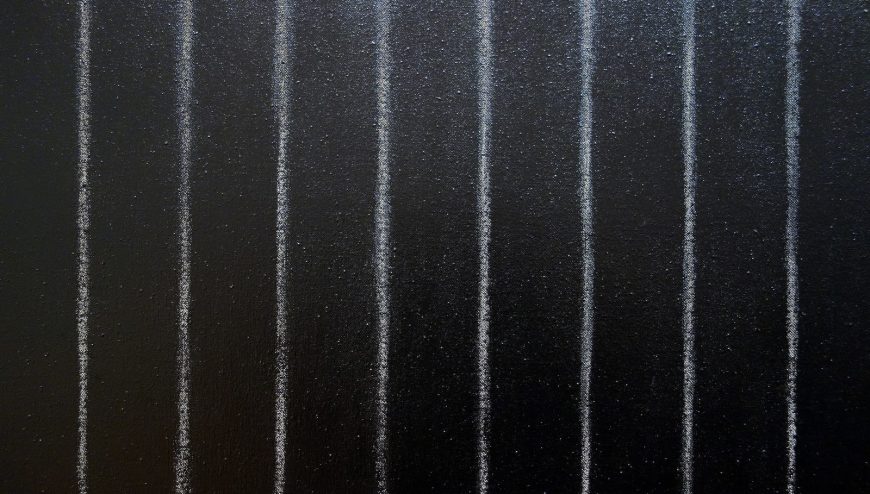
Frank Stella, The Marriage of Reason and Squalor, II (detail), 1959, enamel on canvas, 230.5 x 337.2 cm (The Museum of Modern Art, New York)
Art historian Caroline Jones believes The Marriage of Reason and Squalor II sums up contradictions that are pervasive throughout all the Black Paintings. She writes, “It is precisely the marriage of reason and squalor—the union of control and flow, the matings between differences, the pleasures of conjugation—that allows the procreation of meaning in the Black Paintings (to pursue Andre’s analogy.)” [5] Noting that the painting was the second of two versions of the same composition, Jones shows that, despite Stella’s mechanical stance, close looking (see detail above) reveals tell-tale signs of the artist’s hand: small drips of paint, blurred edges in the black lines, varying widths of the white space in between, and tonal shifts in the layers of color. She even points out how the overall configuration pulls ever so slightly to the right as evidence of Stella’s dominant hand at work. [6]
Like Pop Art, which developed around the same time, Stella’s Black Paintings challenge viewers by representing imagery that is self-evident and lacks expressive impact. For art historians like Jones, this detached approach to art making reflects the economic shift toward mass production and the growing commodity culture of the United States in the 1960s. However, by asking us to consider Stella’s creative process and his motivations for so strongly denying it, The Marriage of Reason and Squalor II also forces us to treat the painting like a traditional work of art, demanding focused attention to its visual effect and intellectual engagement with the conceptual issues it raises.



